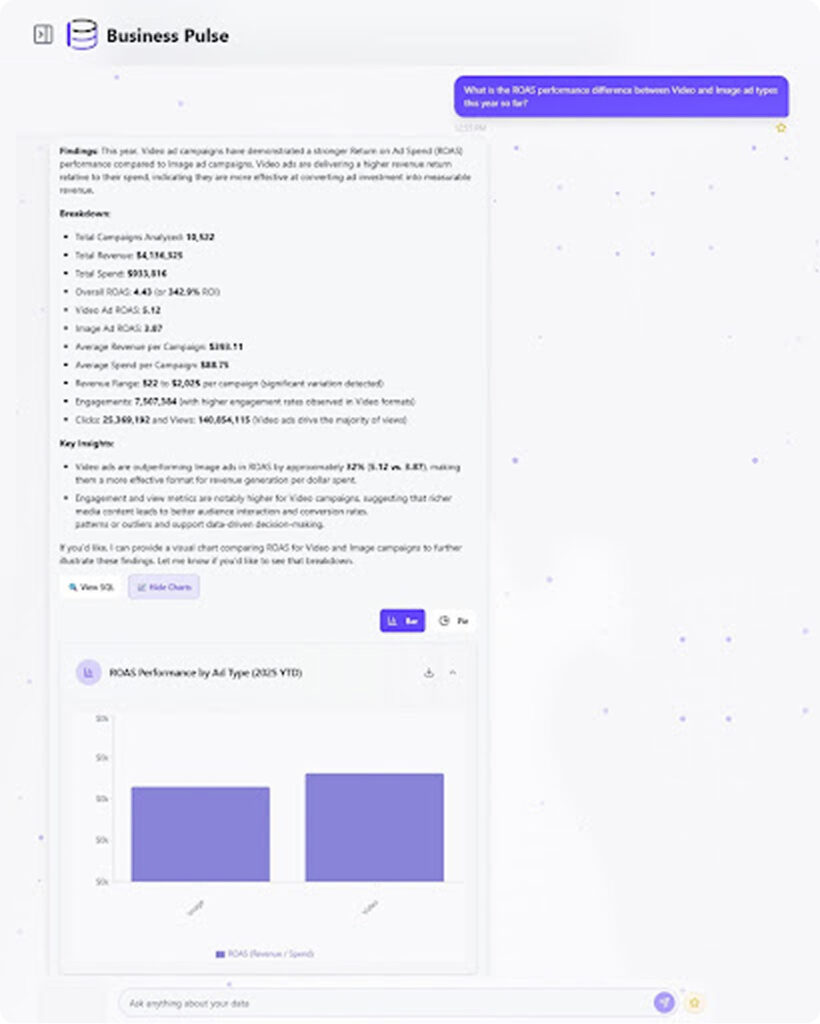Analytics is commonly divided into four types: descriptive, diagnostic, predictive, and prescriptive. Descriptive analytics shows what has happened, diagnostic analytics explains why it happened, predictive analytics forecasts what is likely to happen next, and prescriptive analytics recommends the actions to take.
This article defines each type, outlines their strengths and limitations, and provides examples of the kinds of questions that can be asked in Business Pulse at each stage.
Descriptive analytics focuses on summarizing historical data to show what has already happened. It is the starting point of analysis, providing straightforward reports, dashboards, and summaries of business performance.
Organizations use descriptive analytics when they need a clear picture of past results, such as total revenue, number of new customers, or average resolution time for support tickets. This type of analysis gives decision-makers a baseline understanding before moving into deeper levels of insight.

| Strengths | Limitations |
| Provides a clear summary of historical performance | Does not explain why outcomes occurred |
| Simple to use and widely understood | Cannot predict future trends |
| Offers a baseline for deeper analysis | Limited in guiding decision-making beyond reporting |
Diagnostic analytics focuses on identifying the reasons behind past outcomes. Instead of only reporting numbers, it investigates the contributing factors and relationships that explain performance shifts. This type of analysis is especially useful when a business needs to understand the root causes of trends, anomalies, or sudden changes.
For example, if sales drop unexpectedly, diagnostic analytics can reveal whether it was due to pricing, customer behavior, competitor actions, or operational inefficiencies. Answering the “why,” it provides the context required to make better decisions moving forward.
| Strengths | Limitations |
| Explains the causes behind results | Explains the causes behind the results |
| Helps uncover hidden patterns and correlations | Accuracy depends on data quality |
| Provides context for forecasting and planning | May still require further analysis to guide actions |
Predictive analytics uses historical data, statistical models, and machine learning techniques to forecast what is likely to happen in the future. Rather than only explaining past performance, it provides insights into upcoming trends, potential risks, and future opportunities.
Businesses use predictive analytics when they want to anticipate customer behavior, market shifts, demand fluctuations, or operational bottlenecks. This type of analysis helps organizations prepare in advance, allocate resources more effectively, and reduce uncertainty in decision-making.
| Strengths | Limitations |
| Anticipates future outcomes and scenarios | Predictions are probabilistic, not guarantees |
| Helps businesses plan ahead and allocate resources | Requires robust historical data for accuracy |
| Supports proactive risk management | Can be affected by sudden market or external changes |
Prescriptive analytics goes beyond explanation and prediction to recommend the best possible course of action. It combines historical data, predictive models, and optimization algorithms to suggest specific steps that can improve outcomes.
Businesses use prescriptive analytics when they need to decide how to respond to predicted scenarios – for example, how to prevent churn after identifying at-risk customers, or how to adjust pricing to maximize profitability. This type of analysis provides decision-makers with practical guidance on what actions to take and the potential impact of those actions.
| Strengths | Limitations |
| Provides clear, actionable recommendations | Relies on accurate predictive models |
| Optimizes decision-making by evaluating multiple scenarios | Can be complex to implement across all business areas |
| Helps maximize efficiency and minimize risk | Recommendations may change if input data shifts |
Descriptive, diagnostic, predictive, and prescriptive analytics are not isolated approaches. They build on one another to provide increasing depth of insight. Descriptive analytics summarizes what happened, diagnostic analytics explains why it happened, predictive analytics forecasts what is likely to happen next, and prescriptive analytics recommends the best actions to take in response.
Together, they form a progression that helps organizations move from simply reporting results to actively shaping future outcomes.
| Analytics Type | Focus | Key Questions Answered | Example in Business Pulse | Value to the Business |
| Descriptive | Reporting past outcomes | What happened? | What were the total sales last quarter? | Provides a baseline view of performance |
| Diagnostic | Understanding causes | Why did this happen? | Why did Q2 revenue drop? | Identifies root causes and areas for improvement |
| Predictive | Anticipating future outcomes | What is likely to happen next? | Which customers are likely to churn? | Enables proactive planning and resource allocation |
| Prescriptive | Recommending actions | What should we do about it? | How should we adjust pricing to improve margins? | Provides actionable guidance for better decision-making |
In Business Pulse, analytics types aren’t abstract concepts. They’re built into how users interact with the platform. A typical workflow starts with descriptive reporting, moves into diagnostic analysis, and extends to predictive and prescriptive insights, all within the same interface.
How this progression works in practice:
This workflow allows teams to begin with a factual snapshot, uncover the reasons behind the results, anticipate what’s ahead, and act on data-driven recommendations without switching tools or relying on disconnected reports.
Descriptive, diagnostic, predictive, and prescriptive analytics each serve a distinct purpose. Descriptive analytics shows what has happened, diagnostic analytics explains why it happened, predictive analytics forecasts what is likely to happen next, and prescriptive analytics recommends the best actions to take. Together, they create a framework that enables businesses to understand the past, anticipate the future, and act with confidence.
Business Pulse supports this entire journey by allowing users to start with descriptive reporting and move seamlessly into diagnostic, predictive, and prescriptive insights. This makes it easier for decision-makers to not only interpret results but also to plan ahead and take the right actions based on data-driven recommendations.
Get a free Data Maturity Audit and see exactly where your reporting and decision-making can improve.
Share this Blog

I'm a product marketer with a focus on B2B SaaS products and I love turning complex ideas into clear strategies that fuel growth and retention. When I'm not mapping customer journeys, you’ll find her binge-reading fictional novels.